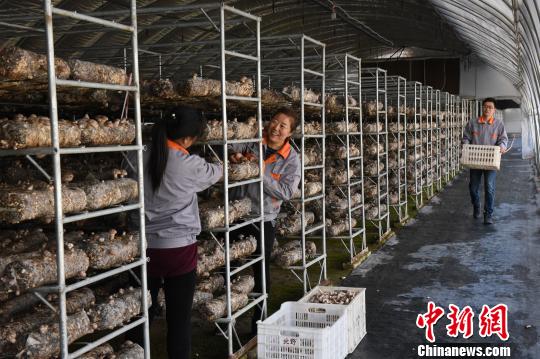China News Service, June 5th, according to the website of the Ministry of Agriculture and Rural Affairs, the Ministry of Agriculture and Rural Affairs recently issued "Guiding Opinions on Promoting the Stable Development of Edible Mushroom Industry in Poor Areas" and "Guiding Opinions on Promoting the Stable Development of Tea Industry in Poor Areas" (hereinafter referred to as "instructions").
The guidance proposes to promote the formation of edible fungus industry with sound facilities, solid foundation, complete chain, stable benefits, and certain brand influence in the poverty-stricken areas; accelerate the transformation and upgrading of the tea industry in the poverty-stricken areas, promote more optimized industrial layout, and more prominent product features, Effectively improve industrial efficiency, help poverty-stricken areas get rid of poverty and get rich, and revitalize rural areas.
Data Map: Employees are picking shiitake mushrooms. Photo by Huo Feifei
To promote the stable development of the edible mushroom industry in poor areas, the key tasks are as follows:
Scientifically determine the scale of the industry. The edible fungus industry in poor areas must adhere to the concept of green development, practice the concept of "green water and green mountains are the golden mountains and silver mountains", and based on the systematic analysis of regional natural resource endowments, industry status and market space, in accordance with scientific planning, superior layout, Highlight the characteristics and market-oriented principles, adhere to appropriate species, build a number of main production areas of the edible fungus industry with outstanding advantages, and constantly optimize the regional structure, industrial structure and product structure of edible fungi.
Effectively strengthen the docking of production and sales. Take multiple measures, increase the construction of the wholesale market, and promote the edible mushroom production and operation entities in poverty-stricken areas to actively "go out", establish contacts with distributors, wholesale markets, fresh supermarkets, canteens of enterprises and institutions, and hotel chains, etc. E-commerce development and expansion of sales channels.
Extend the industrial development chain. Implement grading and grading of edible fungus products, effectively promote the research and development of refined and deep-processed products, and vigorously develop high-value-added products such as edible fungus-derived products and health care products. Excavate the cultural connotation of the edible fungus industry, develop edible fungus creative parks, picking experience and industrial tourism, and promote the integrated development of the first, second and third industries.
Cultivate new business entities. Cultivate and develop new types of business entities such as large edible fungus producers, farmer cooperatives and leading enterprises, promote the transformation from retail production to joint cooperative production, and actively develop enterprise factory production to enhance the degree of industrial development organization.
Enhance the stamina of industrial development. Accelerate the formation of a replicable and promoteable green production model and raise the level of green standardized production. Strengthen the introduction of key technologies and technical integration to improve the overall technical level of the edible fungus industry. Vigorously cultivate edible fungus product brands, regional public brands, and actively declare geographical indication products.
To promote the stable development of the tea industry in poor areas, the key tasks are as follows:
Reasonably control the scale. Adhere to suitable areas and suitable species, suitable species and suitable system, and moderate development. Based on the endowment of resources, give full play to the characteristics of varieties, and promote the improvement of output and quality. Highlight regional advantages, poor tea areas in Sichuan and Hubei, focus on the development of high-quality green tea, black tea and black tea; poor tea areas in Guangdong and Fujian, focus on the development of high-quality oolong tea and famous black tea; poor tea areas in Yunnan, focus on the development of Pu'er and black tea; The poverty-stricken tea areas in Hunan, Guizhou and Guangxi focus on the development of high-quality green tea and black tea.
Consolidate the industrial foundation. Improve and improve the tea garden infrastructure, improve the level of tea garden management and protection, gradually eliminate tea gardens with poor site conditions, low benefits, and high ecological risks, transform a batch of low-yield and low-efficiency tea gardens with good development prospects, and guide new tea gardens to use tea varieties. Promote clean, mechanized, continuous, automated and standardized tea processing. Develop new tea products to improve the comprehensive utilization of tea resources.
Strengthen brand building. Give full play to the dominant position of the enterprise, and actively create and cultivate tea brands. Encourage small and micro tea companies to form alliances with tea farmers or cooperatives to create regional public brands. Increase public marketing efforts, build a production and marketing docking platform, and collect, share, and release production and marketing information. Strengthen information services and publicity and guidance to increase the market influence of tea brands.
Strengthen technological support. Guide and encourage scientific research institutes and colleges to pair up with poor areas, give priority to poor areas to carry out scientific research, technical achievements transformation, technical services and technical training, increase the training of tea industry employees in poor areas, and continuously improve poverty The technological level of the regional tea industry and the scientific and technological qualities of employees.
Effectively guard against risks. Scientifically assess the degree of matching of cultivated tea varieties with local natural conditions to prevent natural risks. Lead the leading enterprises to carry out deep processing of tea, extend the industrial chain, and reduce market risks. Encourage the creation of special insurance products for the tea industry such as over-winter freezing damage for tea trees, freezing damage for falling spring, and high-temperature drought damage in summer to enhance the ability of tea farmers to resist risks.

